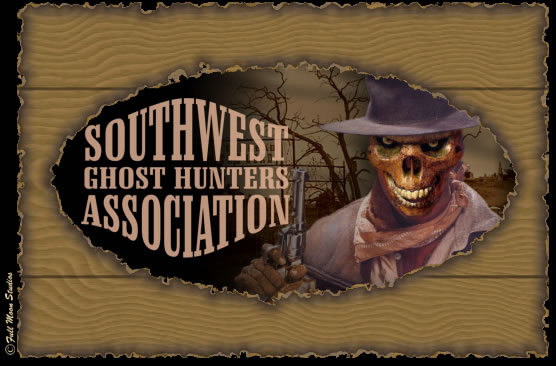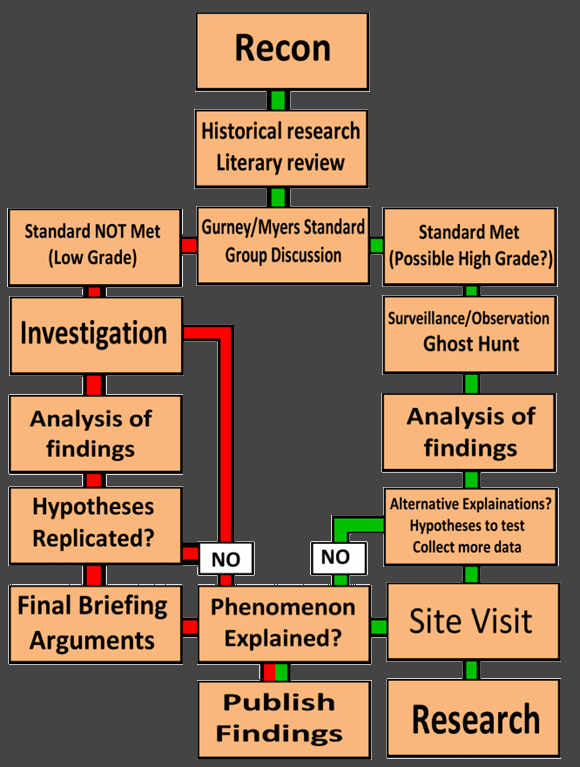1.0 Introduction
The purpose of this document is to explain the operational process of SGHA. However, what we do radically differs from the methodology of most ghost hunting groups. So to accomplish this we must first define what those differences are.
When people think of ghost hunting they often recall what they have seen on television or read about in countless books that have been poorly researched. The simple truth is we do not know what ghosts are or even if they exist. If you do not know what something is, then how are you going to look for it? There is no way to actually detect a “ghost”. Obviously, if we could do that then we could prove their existence. In this way, the TV shows and books are misleading and untruthful. Their methodology is based upon unproven hypotheses that were generated from their own belief systems and prior research that ultimately failed.
The origins of ghost hunting are far older than the groups that have been seen on TV. It actually started over 130 years ago and anyone with the gall to call themselves a “ghost hunter” or a “paranormal investigator” should be aware of what was learned, what was disproven and how the field of paranormal research has evolved.
Well-organized, systematic studies of apparitions started after the Society for Psychical Research (SPR) was founded in England in 1882. The SPR was soon joined in this quest by the American Society for Psychical Research (ASPR) and by smaller research groups and individual investigators in continental Europe. Scholarly journals were established to publish ongoing research as well as theoretical speculation and fierce debates. The basic idea of these efforts was to apply scientific method to data collection, evaluation, and interpretation of psychic phenomena, an area which nineteenth-century materialistic science had ignored up to that time.
Advertised appeals brought an abundance of material, much of it reported in the Proceedings and Journals, leading in 1886 to the publication of Phantasms of the Living. This was followed by a landmark Census of Hallucinations, whose findings were published in the proceedings in 1894.
It was a pioneering survey, 17,000 respondents were contacted. The reports were analyzed and published in several major works. The main analysis done by Edmund Gurney was published in two volumes called Phantasms of the Living. Other important papers were written by Gurney (1886) and Myers (1903). Several other collections appeared later, such as those by Bennett (1939), Green and McCreery (1975), Jacobson (1973), and Jaffé (1979).
With the benefit of hindsight, several conditions pertaining in the late nineteenth century can be seen to have been peculiarly conducive to research into ghostly phenomena. The simple fact is that they discovered that 70 to 90% of all reported cases of ghostly phenomenon are actually explainable. The major explanations were identified as misperceptions of normal events by the witnesses, the bias of the witness and the creation and propagation of folklore (myth building). Additionally, they used the information they uncovered to create a classification system for the reported accounts of hauntings. The classifications they created consist of only two types, “Low Grade” and “High Grade”.
The work of the early researchers established the main methodological principles and the main areas of research. It also defined the major issues that caused failures of experiments and contamination of data. All of this knowledge was used to create a standard that should be used when investigating accounts of ghostly phenomenon.
The Gurney/Myers Standard for Ghost Investigations
It is important to know that other organizations have different names for this standard (the SPR Standard and the Standard for Spectral Phenomenon for instance) however the importance of the standard is vital is you are serious about investigating hauntings and ghosts. People have “paranormal” experiences all the time and most are explainable through psychology due to the affects of one’s belief system, worldview and the bias that they create. This has been extensively studied and multiple scientific papers have been published about this subject.
You might have heard the phrase, “If you want to see a ghost you will”. The standard is designed to provide a way to eliminate the normal psychological factors by focusing on the veridical elements that were identified by the early researchers of psychical phenomenon.
The basis of the standard is actually quite simple. It takes an approach of eliminating the known factors that can be identified and accessed in validity. While it cannot be used to prove a haunting, it can be used to eliminate the common factors that create legends and myths. If the standard is met, the mystery will still remain (as does the possibility of a paranormal oriented cause). It may sound like a backwards approach to investigating but it is the only HONEST way to go about it.
Information gathered about a location can then be sorted and analyzed to determine if it fits into one of four myth building models. The models were developed to help identify myths that have propagated to the extent where they are now considered to be legitimate haunted places.
2.0 Mission
The mission of the Southwest Ghost Hunter’s Association revolves around two concepts.
2.1 Expanding knowledge by disseminating information.
This is accomplished by publishing investigation reports, research findings and articles that are applicable to the field of ghost investigation and research.
2.2 Indirect support of academic studies on hauntings and apparitions.
This is done by Identifying and investigating alternative explanations for anomalous or “unexplained” events that are believed to be paranormal.
3.0 What does SGHA do?
Basically, SGHA uses the Gurney/Myers Standard to investigate the mysteries of haunted locations. Is there really something paranormal occurring or does it have a rational explanation? This is accomplished through three types of activities, the ghost hunt, the ghost investigation and historical research and literary review.
3.1 The Ghost Hunt
Ghost hunting is the process of investigating locations that have met the Gurney/Myers Standard. Because of this a more in depth investigation of the location and the witnesses to the phenomenon is required. The procedures we use for ghost hunting are outlined in the Standard Operating Procedure (SOP) 300.
3.2 The Investigation
The investigative process is initiated when the paranormal claims do not met the criteria of the Gurney/Myers Standard. It is important to understand that the goal of an investigation is not to find evidence of the paranormal but to attempt to identify and/or replicate any natural or manmade causes of the reported phenomena. The procedures we use for investigations are outlined in SOP 301.
3.3 Historical Research and Literary Review
The purpose of historical research and literary review is to check any associated facts to determine their validity and to assist in determining the degree of myth building. Often myths are identified just by checking out the history of a location. When we choose to share our findings with the public, the location will be assigned one of the three categories listed below.
Solved
Locations are assigned this classification when the reported phenomenon was studied and the Gurney/Myers Standard was not met. Additionally, the following conditions may also be present;
- Witness accounts of paranormal phenomena have been identified as an explainable phenomenon and successfully replicated.
- The stories change over time (Myth Building)
- The historical facts do not match the account in the back story of the reported phenomenon
- The reported accounts lack the proper longevity. (The ghost was believed to be a person that died in 1950 but the accounts of paranormal phenomenon did not start until 2001.)
- The reported phenomenon is random and fits within the framework of a myth building model.
- The phenomenon surrounding the location has been discovered to be a hoax.
- The presence of alternative explanations is so great that it outweighs the possibility of a paranormal oriented cause.
Unsolved / Open
Locations that have this classification are still being studied. Some part of the mystery still remains or veridical elements are present. These reports are published in the hopes that other researchers and investigators might provide some additional insight to sway the findings in one direction or another.
Unsolved / Closed
Locations that have been assigned this classification have one of two possible outcomes.
1.) There is insufficient data or confounding variables that prevents replication or identifying possible explanations. This often occurs when investigators do not have direct access to witnesses or some other environmental change has occurred that creates confounding variables.
2.) The location has met the conditions of the Gurney/Myers Standard preventing the mystery from being solved directly. A paranormal oriented cause may still be possible.
Standard of Minimum Controls
A scientific control is an experiment or observation designed to minimize the effects of variables other than the single independent variable. This increases the reliability of the results, often through a comparison between control measurements and the other measurements.
- SOPs (Standard Operating Procedures) must be followed at all times. It is vital that procedures are done exactly the same way each time. Failure to do this creates variables in how we collect data. The reason why it’s important to control the variables is so you can track how results change as variables are changed. This helps you determine which environmental variables can alter results and which are benign. Controlling the variables is also important when an experiment might undergo peer review before publication in a scientific journal. In this situation, the experiment needs to be repeated exactly to see if others can verify results.
- All equipment that is used by the investigators (meters, cameras and such) must be inspected and have an operational check performed. New batteries are required in all instrumentation. Once again, the SOPs on the instrumentation use must be followed so that the data is collected the same way each and every time. Failure to do this may create systematic errors. Systematic errors are biases in measurement which lead to the situation where the mean of many separate measurements differs significantly from the actual value of the measured attribute. All measurements are prone to systematic errors, often of several different types. Sources of systematic error may be imperfect calibration of measurement instruments (zero error), changes in the environment which interfere with the measurement process and sometimes imperfect methods of observation can be either zero error or percentage error.
- All personnel must be accounted for at all times. This includes authorized by-standers such as building owners and employees. All team members need to have radio communication or line of sight with the base station or Team Leader.
- Power to the location must be turned off at the breaker box if possible. If complete power cannot be turned off, then attempt to shut off breakers in the areas where the investigation is focusing on. This is done to minimize man made electromagnetic fields.
- Movement around the location is controlled and monitored. The Team leader must approve any deviation from the assigned positions or unauthorized movement. Positions of the Team and approved movement around the location are briefed to the team during the pre-trip briefing.
- A single investigator should never be left alone unless specified in the pre-trip briefing. (Wingman Control)

